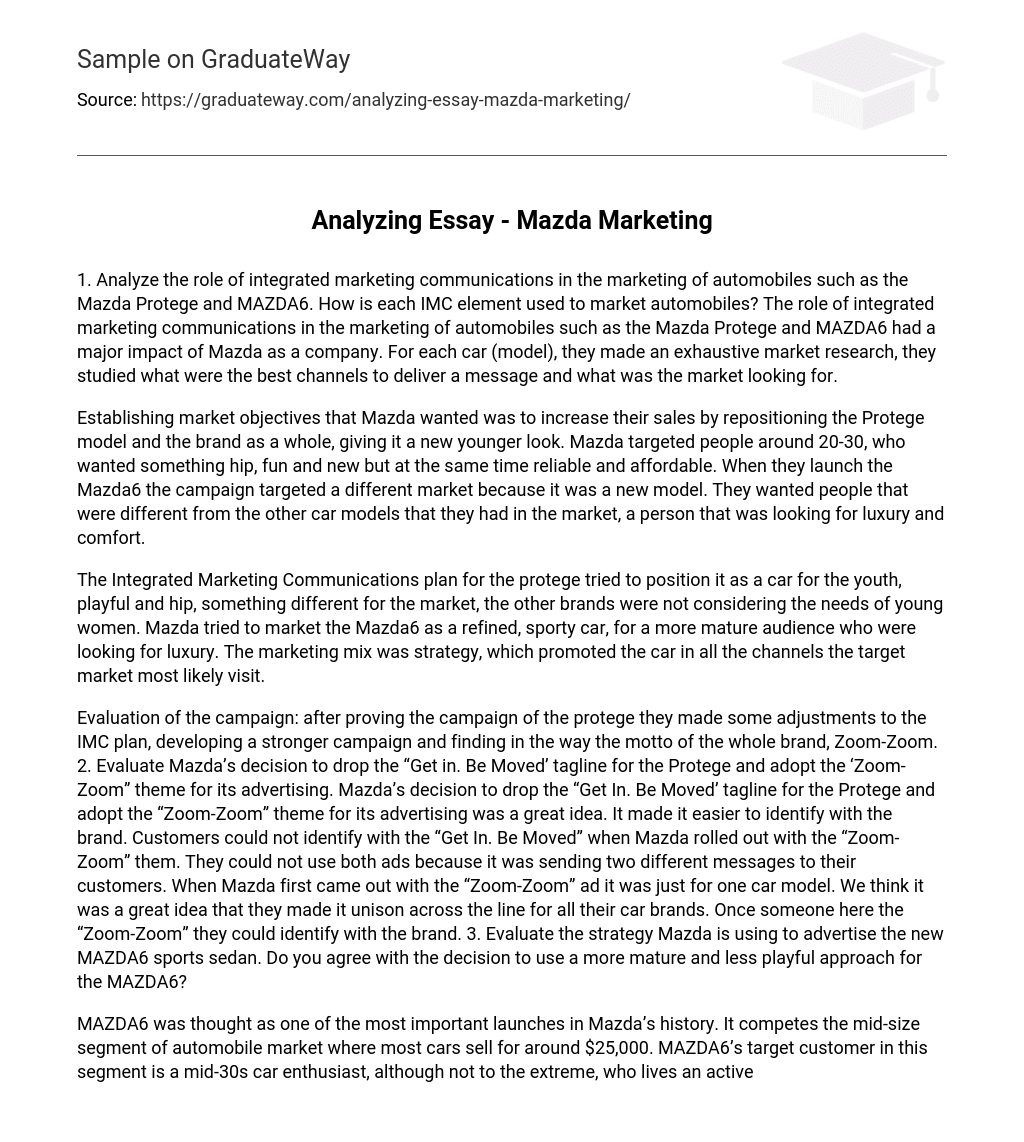Integrated marketing communications has had a significant impact on Mazda as a company, particularly in the marketing of automobiles like the Mazda Protege and MAZDA6. Mazda conducted thorough market research for each car model to identify the most effective channels for delivering their message and to gain insights into market needs.
Establishing market objectives for Mazda involved increasing sales by repositioning the Protege model and the overall brand to appeal to a younger demographic. They aimed to create a new, youthful image while maintaining reliability and affordability. When launching the Mazda6, the campaign targeted a separate market seeking luxury and comfort, setting it apart from their other car models in the market.
The Integrated Marketing Communications plan for the protege aimed to portray it as a youthful and trendy car, offering something unique in the market that other brands had ignored. Mazda’s approach to marketing the Mazda6 was to position it as a sophisticated and sporty vehicle, targeting a more mature audience seeking luxurious features. The marketing mix involved a strategic promotion of the car through various channels that the target market frequently engages with.
After evaluating the campaign for the Protege, adjustments were made to the IMC plan. This resulted in the development of a stronger campaign and the discovery of the brand’s motto, “Zoom-Zoom”.
Mazda’s decision to replace the “Get in. Be Moved” tagline for the Protege with the “Zoom-Zoom” theme for its advertising was a smart move. It made the brand more relatable, as customers could not connect with the previous tagline. Using both ads would have created conflicting messages. Initially, the “Zoom-Zoom” ad only applied to one car model, but expanding it across all their brands was a great idea, as it allowed customers to easily identify with the brand.
As for the strategy to advertise the new MAZDA6 sports sedan, it takes on a more mature and less playful approach. While some may disagree, overall it seems like a reasonable decision.
MAZDA6 is considered one of Mazda’s most significant launches. It competes in the mid-size segment of the automobile market, where cars typically sell for approximately $25,000. The target customers for MAZDA6 are car enthusiasts in their mid-30s who lead active lifestyles. Mazda Company should focus its advertising strategy on these customers. One positive aspect of the MAZDA6 advertising strategy is that it represents a departure from the approach used for the Protege, as it is described as a “more mature” effort.
Mazda employed a comprehensive communications program to promote the MAZDA6. In terms of budget allocation, 12 percent was dedicated to print advertising, including placements in enthusiast, lifestyle magazines, and newspapers. However, one drawback of the advertising strategy was the failure to emphasize the distinctions between the MAZDA6 and other sedans such as Honda. It is possible that customers have less awareness of the MAZDA6 compared to the Protege.
From their advertising, the inclusion of the “Zoom-Zoom” line in campaigns for both the Protege and MAZDA6 creates uncertainty among customers. The advertising for both models lacks precision. Specifically, if the advertising were used on ESPN, it may not effectively target MAZDA6’s intended customers. The target customers of ESPN may not align with the decision to adopt a more mature and less playful approach for the MAZDA6. Overall, Mazda’s advertising strategy for the new MAZDA6 sports sedan fails to fully meet its objectives. Personally, I disagree with the decision to take a more mature and less playful approach for the MAZDA6.
The MAZDA6 is a sports sedan that closely resembles the Protege in terms of performance. However, compared to its competitors, the MAZDA6 takes a more mature and less playful approach. This may pose a challenge for customers trying to distinguish it from other options. The target market for the MAZDA6 consists of individuals in their mid-30s who tend to have both mature and playful characteristics. Hence, when deciding on the appropriate approach for the MAZDA6, it is crucial to consider the preferences of these target customers.
The MAZDA6 has taken on a more mature and less playful approach, which I disagree with. This decision may appeal to an older audience (in their mid-40s) instead of the desired younger demographic (in their mid-30s).
Regarding Mazda’s future integrated marketing communications strategy, I recommend tailoring their approach to each specific target group they aim to engage.
To capture the attention of different demographic groups, Mazda must employ diverse marketing strategies that consider consumer income, age, gender, lifestyle, location, and season. It is crucial for Mazda to establish a strong presence in its target audience’s lives by consistently promoting its products through television commercials and advertisements aired at times when consumers are likely to be at home and available to watch them.
Businesses in today’s society must use social media platforms to showcase their products and engage with customers online. The Internet has a profound impact on people of all generations. Mazda can effectively share new ideas about their models and collect public feedback through online blogs. Additionally, Mazda can keep their loyal customers informed and attract potential customers by sending newsletters directly to their homes. These newsletters provide updates on the automotive industry as well as specific news related to the Mazda Company.
One approach Mazda can take is by inviting both past Mazda customers and new customers to participate in seminars where they can learn about the latest models and technology. Additionally, they can offer free test drives of new cars. The key to a successful marketing communication strategy lies in instilling motivation and trust in consumers through promotional efforts and advertisements. It is not an easy task and requires time and patience for Mazda to achieve this objective.





